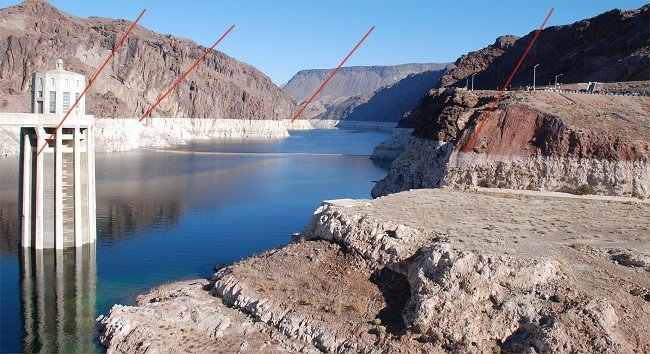 | |
| Images of different areas of the Las Vegas Valley. |
Las
Vegas City elicits the idea of a fantasy land isolated from social
constraints and the rest of the United States. Elaborate scenes running
down the Strip mimic Paris, Egypt, the ocean, and other famous places
from around the world. Even residential homes mimic other homes around
the United States by having non-native drought intolerant grass lawns.
The city is surrounded by stretches of one of the harshest environments,
but in the glitz of the Empire State Building and bright green lawns
that thought is far in the back of the mind. This culture of
transplanting lifestyles suited for their original locations denies the
realities of living in a desert. The extreme amounts of water needed to
maintain the non-native grass landscapes is a hallmark of this denial,
and one reason why water is a key conservation priority. This website
will give an introduction to water conservation in the Las Vegas Valley that focuses on residential
grass landscaping. A look at past regulations and the current course the South
Nevada Water Authority is taking towards changing residential lifestyles reveals that more unified approaches aimed at environmental conservation significantly lower short term water use and set the Valley up for long term water conservation improvements.
The Las Vegas Valley in Nevada has the greatest concentration of people in the state, with roughly 2 million of the 2.7 million total people. It is an ancient dried up lake basin located in the Mojave Desert. Extreme temperature fluctuations, with highs of 110 Fahrenheit degrees and lows that drop below zero during winter nights, sparse clouds and low humidity mean that the average rainfall is 4.49 inches a year, and water evaporates very easily. Being in the area for as little as a day causes skin to dry out so severely that it begins to crack. Despite these extreme conditions, the early settlers named the area Las Vegas which means “The Meadows” because the area was flush with vegetation growing around the Colorado River and Las Vegas Wash. From the early settlements in the 1800’s until the mid 1900’s, water from this river and tributary, as well as water found under ground, was more than sufficient for the small population.
The Las Vegas Valley in Nevada has the greatest concentration of people in the state, with roughly 2 million of the 2.7 million total people. It is an ancient dried up lake basin located in the Mojave Desert. Extreme temperature fluctuations, with highs of 110 Fahrenheit degrees and lows that drop below zero during winter nights, sparse clouds and low humidity mean that the average rainfall is 4.49 inches a year, and water evaporates very easily. Being in the area for as little as a day causes skin to dry out so severely that it begins to crack. Despite these extreme conditions, the early settlers named the area Las Vegas which means “The Meadows” because the area was flush with vegetation growing around the Colorado River and Las Vegas Wash. From the early settlements in the 1800’s until the mid 1900’s, water from this river and tributary, as well as water found under ground, was more than sufficient for the small population.
 |
| Top: The white bathtub like ring indicated by the red lines shows where the water level was when the lake was formed because of the Hoover Dam. Since January 2000 the water level has dropped one hundred feet. The intake valve appearing on the left side will be too tall for the expected water levels in the coming years, so the South Nevada Water Authority is now in the process of constructing a third intake valve that will be able to draw in these lower water levels. More information about the status of Lake Mead. Once the water flowed over the Hoover Dam. Bottom: A depiction showing at what levels the intake valves are able are able to take in water. |
When the Colorado River Compact was signed in 1922 by seven states and Mexico, Nevada was allowed to divert 300,000 acres-ft per year (MAFY), the one of the smallest amounts of all the parties involved because there was little need at the time or in the foreseeable future. Soon after the Hoover Dam was built 1936, Lake Mead was formed and the people of the Las Vegas Valley began to divert greater and greater amounts of water from Lake Mead. By 1990, the Valley was demanding all of the allowed 300,000 acre-ft of water. Today, ninety percent of Las Vegas Valley’s water supply comes from Lake Mead and ten percent comes from underground sources. The water levels in Lake Mead have dropped below the drought line three times in the 2000’s and have been so consistently low that the Southern Nevada Water Authority has begun construction of a shorter third water intake valve in Lake Mead because the two current ones are too high for water to flow in.
 |
| The path of the Colorado River runs through seven states and Mexico. Nevada 300,000 acre-ft/year; California 4,400,000 acre-ft/year; Utah 1,700,000 acre/ft per year; Wyoming 1,000,000 acre-ft/year; Colorado 3,900,000 acre-ft/year; New Mexico 850,000 acre-ft/year; Arizona 2,850,000 acre-ft/year; Mexico 1,500,000 acre-ft/year. |






